NRG4
-
Official Full Name
neuregulin 4 -
Overview
Neuregulin 4 also known as NRG4 is a member of the neuregulin protein family which in humans is encoded by the NRG4 gene. The neuregulins, including NRG4, activate type-1 growth factor receptors (EGFR) to initiating cell-to-cell signaling through tyrosine phosphorylation. -
Synonyms
NRG4;HRG4;neuregulin 4;heregulin 4;pro-NRG4;pro-neuregulin-4, membrane-bound isoform
Recombinant Proteins
- Mouse
- Human
- Chicken
- Rat
- E.coli
- Mammalian Cells
- HEK293
- His
- GST
- Non
- Avi
- Fc
- SUMO
Background
What is NRG4 protein?
NRG4 (neuregulin 4) gene is a protein coding gene which situated on the long arm of chromosome 15 at locus 15q24. Neuregulin 4 also known as NRG4 is a member of the neuregulin protein family which in humans is encoded by the NRG4 gene. NRG4 is a member of the neuregulin family and is mainly expressed in the body's brown adipose tissue as well as other metabolically active tissues. This protein contains an epidermal growth factor (EGF) -like domain, suggesting that it plays a role in cellular signaling. The NRG4 protein is consisted of 115 amino acids and its molecular mass is approximately 12.7 kDa.
What is the function of NRG4 protein?
NRG4 activates downstream signaling pathways by binding to ErbB receptor tyrosine kinase, thereby regulating physiological processes such as neurodevelopment, synaptic transmission, insulin sensitivity, and energy metabolism. Specifically, NRG4 is involved in neuronal growth, differentiation, and synaptic plasticity, while also playing a role in regulating adipose tissue function and maintaining glucose homeostasis.
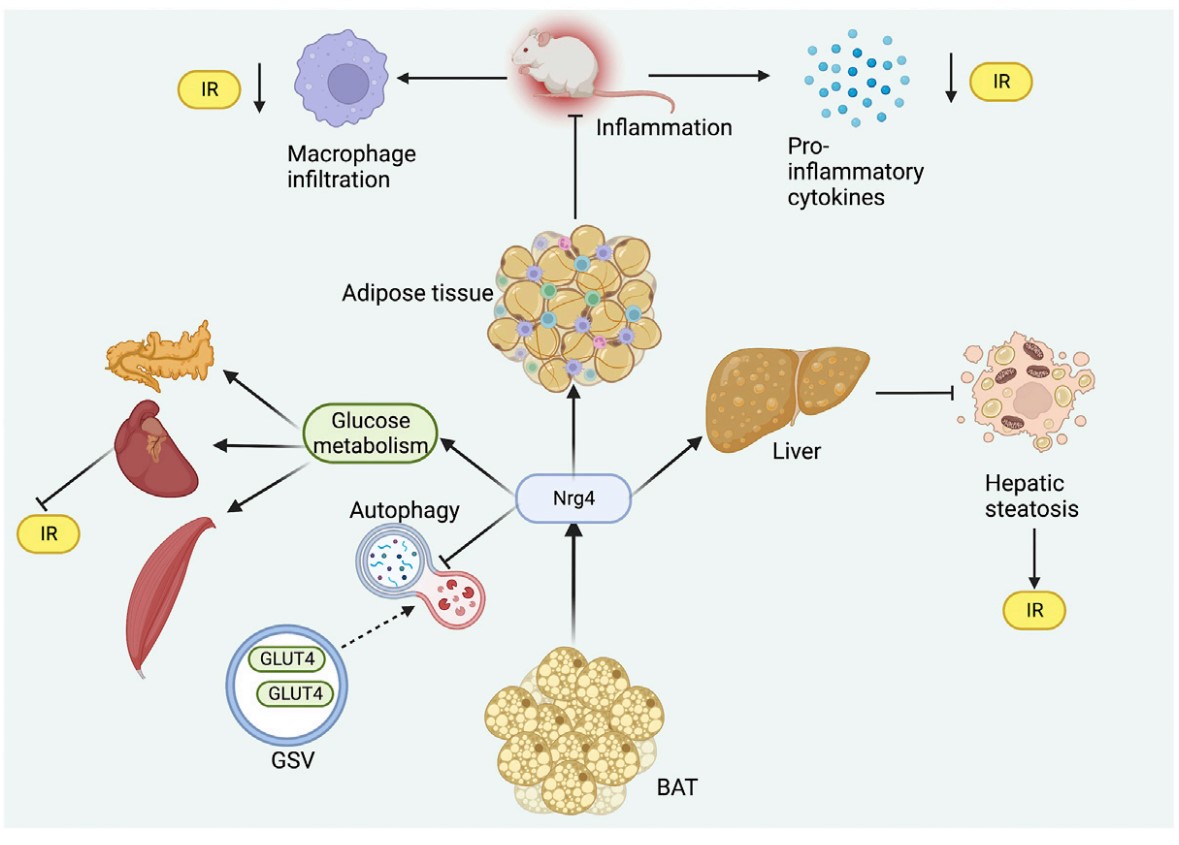
Fig1. Role of Nrg4 in IR. Nrg4 ameliorates inflammation in adipose tissue by reducing macrophage infiltration and pro-inflammatory cytokine levels. (Yuanbin Liu, 2023)
NRG4 Related Signaling Pathway
NRG4 is a secreted protein that initiates signal transduction primarily by binding to the cell surface receptor ErbB. NRG4 binding to ErbB receptor can activate a variety of downstream signaling pathways, and participate in the regulation of neurodevelopment, cardiac function, energy metabolism, insulin sensitivity and other physiological processes. Includes:
PI3K/Akt pathway: This is a key pro-survival pathway that promotes cell survival, proliferation, and metabolism. Ras/MAPK pathway: This pathway regulates cell proliferation, differentiation, and apoptosis. PLCγ pathway: Activation of this pathway leads to changes in intracellular calcium ion concentration and activation of protein kinase C (PKC), which affects a variety of cellular functions.
NRG4 Related Diseases
Mouse models of NRG4 knockouts show phenotypes such as weight gain, altered adipose tissue distribution, and insulin resistance, suggesting that NRG4 may play a role in the pathogenesis of obesity, type 2 diabetes, and related metabolic syndrome. At the same time, its abnormal expression or functional impairment may be related to some cardiovascular diseases, schizophrenia, depression and other mental health diseases.
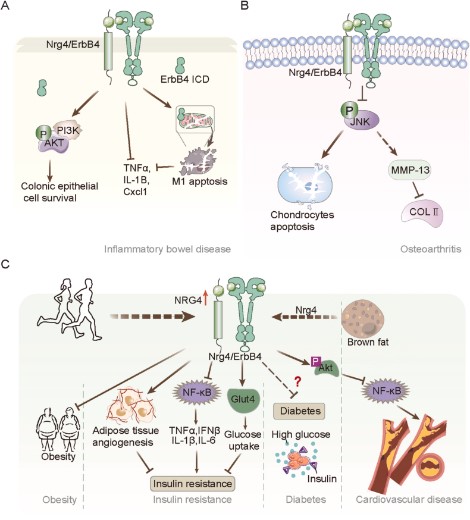
Fig2. The effects of Nrg4 on inflammatory diseases, obesity, insulin resistance, diabetes, and cardiovascular diseases. (Min Chen, 2023)
Bioapplications of NRG4
By modulating the activity of NRG4, it may help to develop new therapeutic strategies to improve metabolic disorders and neurological diseases. Although still in the early stages of research, these findings offer hope for future therapeutic applications, especially in the treatment of insulin resistance, type 2 diabetes, and related metabolic disorders, where NRG4 and its signaling pathway are expected to be important therapeutic targets.
Case Study
Case study 1: Guo-Xiao Wang, 2014
Brown fat activates uncoupled respiration in response to cold temperature and contributes to systemic metabolic homeostasis. To date, the metabolic action of brown fat has been primarily attributed to its role in fuel oxidation and uncoupling protein 1 (UCP1)-mediated thermogenesis. Whether brown fat engages other tissues through secreted factors remains largely unexplored. Here the researchers show that neuregulin 4 (Nrg4), a member of the epidermal growth factor (EGF) family of extracellular ligands, is highly expressed in adipose tissues, enriched in brown fat and markedly increased during brown adipocyte differentiation. Adipose tissue Nrg4 expression was reduced in rodent and human obesity. Gain- and loss-of-function studies in mice demonstrated that Nrg4 protects against diet-induced insulin resistance and hepatic steatosis through attenuating hepatic lipogenic signaling. Mechanistically, Nrg4 activates ErbB3 and ErbB4 signaling in hepatocytes and negatively regulates de novo lipogenesis mediated by LXR and SREBP1c in a cell-autonomous manner.
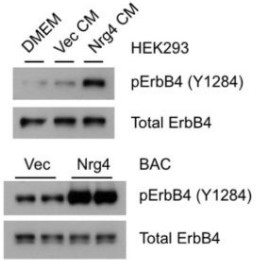
Fig1. Secretion of Nrg4 into culture media. Shown are immunoblots of total lysates from ErbB4-Min6 cells treated with DMEM or concentrated conditioned media (CM) from HEK293 (top) or BAC (bottom) expressing vector (Vec) or Nrg4.
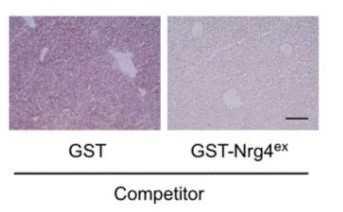
Case study 2: Steven J McElroy, 2014
Necrotizing enterocolitis (NEC) affects up to 10% of premature infants, has a mortality of 30%, and can leave surviving patients with significant morbidity. Neuregulin-4 (NRG4) is an ErbB4-specific ligand that promotes epithelial cell survival. Thus, this pathway could be protective in diseases such as NEC, in which epithelial cell death is a major pathologic feature.
NRG4 was used i) in the newborn rat formula feeding/hypoxia model; ii) in a recently developed model in which 14- to 16-day-old mice are injected with dithizone to induce Paneth cell loss, followed by Klebsiella pneumoniae infection to induce intestinal injury; and iii) in bacterially infected IEC-6 cells in vitro. NRG4 reduced NEC incidence and severity in the formula feed/hypoxia rat model. It also reduced Paneth cell ablation-induced NEC and prevented dithizone-induced Paneth cell loss in mice. In vitro, cultured ErbB4(-/-) ileal epithelial enteroids had reduced Paneth cell markers and were highly sensitive to inflammatory cytokines. Furthermore, NRG4 blocked, through a Src-dependent pathway, Cronobacter muytjensii-induced IEC-6 cell apoptosis.
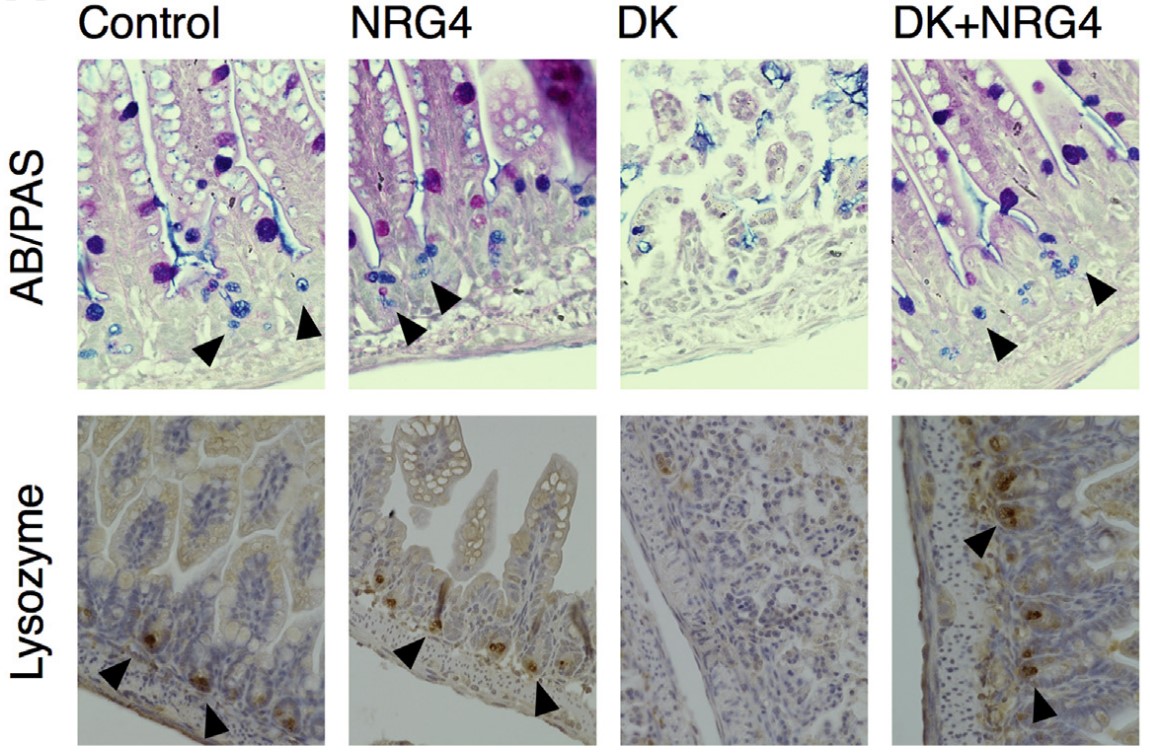
Fig3. leums from 14-day-old mice subjected to DK NEC, with or without NRG4, underwent staining by Alcian blue/periodic acid–Schiff (AB/PAS) and immunohistochemical analysis for lysozyme to identify Paneth cells.
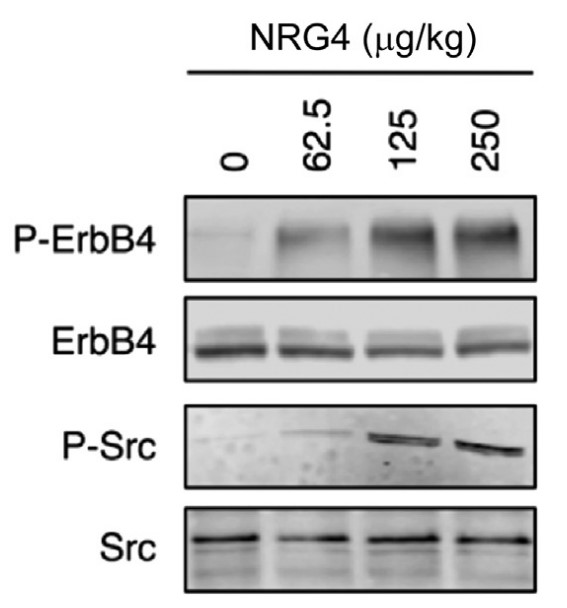
Quality Guarantee
High Purity
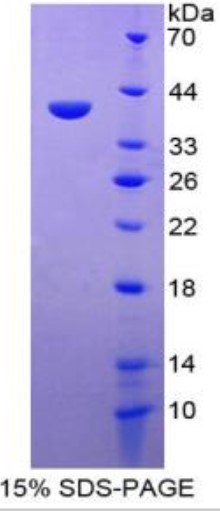
Fig1. SDS-PAGE (NRG4-365H) (PROTOCOL for western blot)
.
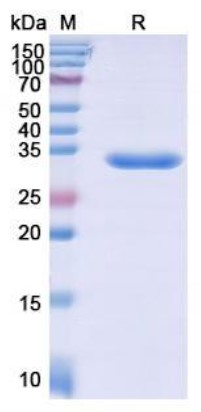
Fig2. SDS-PAGE (NRG4-4042H) (PROTOCOL for western blot)
Involved Pathway
NRG4 involved in several pathways and played different roles in them. We selected most pathways NRG4 participated on our site, such as ARMS-mediated activation,Adaptive Immune System,Axon guidance, which may be useful for your reference. Also, other proteins which involved in the same pathway with NRG4 were listed below. Creative BioMart supplied nearly all the proteins listed, you can search them on our site.
| Pathway Name | Pathway Related Protein |
|---|---|
| Developmental Biology | CSNK2A2,SPRED1,KIF4A,MED8,NRP1A,PAK4,NR5A1,DLG3,PLXND1,CACNG8A |
| ARMS-mediated activation | PSMD9,SPTA1,WDR83,CSF2RB,SPTBN2,DUSP10,KLB,NTF7,CNKSR1,SPRED1 |
| DAP12 signaling | SPNA1,FRS2A,FRS3,NRG2A,TRAT1,GRAP2B,FGF20A,FGF10B,FGFR1B,KLB |
| Cytokine Signaling in Immune system | RASGRP1,TRIM46,TRIM38,SOCS3A,JAK1,SPTB,FRS3,PEA15A,IL17RD,IRF2 |
| DAP12 interactions | PHB,CSF2RA,FRS3,SPNA2,FGF10B,SPTA1,CLEC5A,KBTBD7,SPNA1,NRG2A |
| Axon guidance | PAK1,FGF18B,ARHGEF12,ROCK2,DOCK1,JAK2,IL17RD,GNAI1,UNC5A,CSF2 |
| Adaptive Immune System | ASB11,AGO3,TRIM63,KLRB1B,FGF20A,KIF5A,SIGLEC10,ASB10,CD200R2,CTSK |
| Constitutive Signaling by Aberrant PI3K in Cancer | KLB,FRS2,EGF,TRAT1,HBEGF,NRG3 |
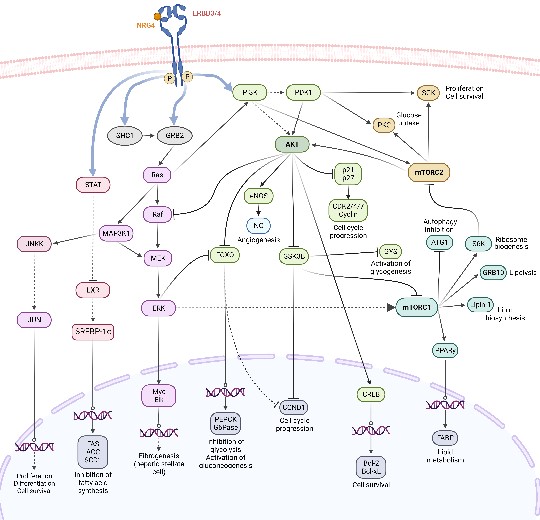
Fig1. Regular ERBB4 membrane signaling and resulting metabolism-related processes. (Maria Vulf, 2023)
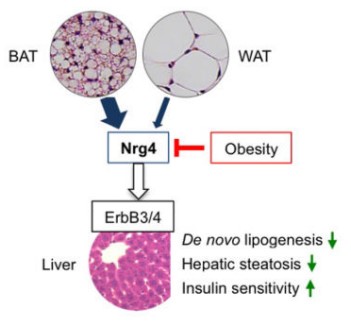
Fig2. Model of Nrg4 as a brown fat-enriched secreted protein that preserves metabolic homeostasis in diet-induced obesity. (Guo-Xiao Wang, 2014)
Protein Function
NRG4 has several biochemical functions, for example, growth factor activity,protein binding,receptor binding. Some of the functions are cooperated with other proteins, some of the functions could acted by NRG4 itself. We selected most functions NRG4 had, and list some proteins which have the same functions with NRG4. You can find most of the proteins on our site.
| Function | Related Protein |
|---|---|
| receptor binding | PARK7,SRMS,RSPO2,FGF8A,FGF6A,LAMA1,ASIP,CAT,TENC1,GIPC1 |
| protein binding | CLEC16A,FHL5,VAMP5,ADAM8,SGOL2,ZNF26,POR,SMAD3A,POLRMT,ATPAF2 |
| growth factor activity | GH1,LFT2,KLK1B4,NTF4,FGF13A,INHA,BMP7B,TIMP1,GDF7,VEGFAA |
Interacting Protein
NRG4 has direct interactions with proteins and molecules. Those interactions were detected by several methods such as yeast two hybrid, co-IP, pull-down and so on. We selected proteins and molecules interacted with NRG4 here. Most of them are supplied by our site. Hope this information will be useful for your research of NRG4.
FATE1;CREB3
Resources
Gene Families
Research Area
Related Services
Related Products
References



